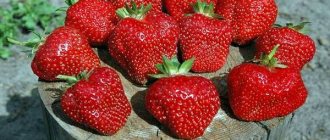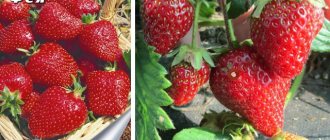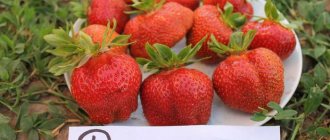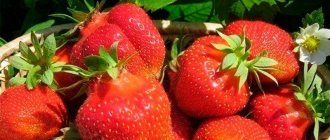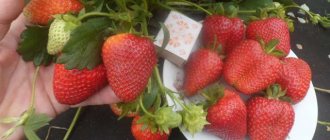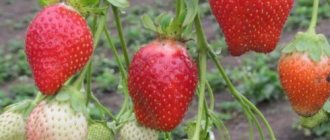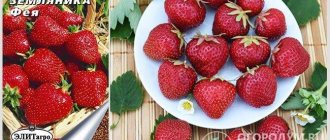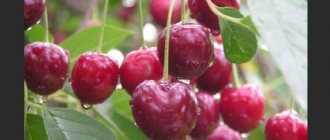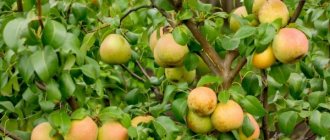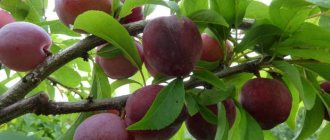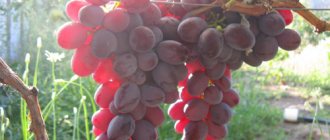Strawberry variety Maestro
Strawberry Maestro is a remontant variety of medium ripening, recently bred in France, it is still little known to Russian gardeners. In 2021, its first representatives began to arrive on the markets of Russia and neighboring countries. Keen berry gardeners purchase Maestro strawberry seedlings with caution and only take small batches for testing. This is understandable, because there is very little information about the new variety, so before you buy a lot, you need to find out about the properties of the berry: its yield, taste, growing conditions. Indeed, there are not enough descriptions of the varietal qualities of this berry, but we have collected them bit by bit and bring them to your attention.
Flaws
- If there is insufficient illumination of the bed or a long absence of watering, Maestro strawberries almost do not form tendril shoots, which can lead to a lack of new seedlings for propagation.
- The establishment of new seedlings takes quite a long time, so it is better to buy and plant bushes with a closed root system or with a lump of mother substrate.
- Maestro strawberries have a rather short lifespan of roots; after 3 years, the beds need to be completely renewed.
Characteristics of the variety
There are a lot of strawberry varieties, the choice is huge, many of them meet all the requirements for growing on our gardeners’ plots in areas with not very favorable climatic conditions. Breeders are constantly working to improve the quality of strawberries: increasing productivity, resistance to diseases and pests, improving the large fruit size and appearance of the berries. How can the new Maestro variety please them? Let's start from the very beginning, that is, with what varietal qualities it has.
Strawberry Maestro refers to a variety of pineapple strawberry that does not exist in wild plant form, and the name “strawberry” is its everyday definition. We will not change the generally accepted names; this is what many gardeners call it, and we are writing specifically for them. The main botanical data of Maestro strawberries are as follows:
- strawberry roots are fibrous, superficial, lie at a depth of no more than 30 cm, the life cycle is 3-4 years, after time it is necessary to remove them from the garden bed, replacing them with young seedlings;
- Maestro strawberry leaves are trifoliate (there are 3 leaves on one leaf plate), located on petioles up to 25 cm high, the color of the leaves is light green, becoming dark green as they grow;
- strawberry shoots are creeping, each producing from 1 to 3 (or more) rosettes of leaves that can take root on their own;
- flowers - located on long peduncles growing from the root collar, white (sometimes yellowish or pink), bisexual, self-pollinating, good honey plants;
- Maestro strawberry fruits are complex nuts (seeds) fused into false berries, covered with a juicy red shell, large, weighing 40 g, measuring up to 5-7 cm in length.
Gardeners call such periods “waves.” The first “wave” is always distinguished by the large size of the berries, but their quantity is small.
Advantages
- Strawberries Maestro belongs to day-neutral varieties, which means that the growing season is not affected by the length of daylight hours and a certain temperature, as with conventional short- or long-day varieties. The plant forms fruit ovaries every 1-1.5 months, their growing season occurs within 14-16 days, regardless of the above indicators.
- The yield of Maestro strawberries does not upset gardeners: from one bush per season they collect up to 2-2.5 kg of berries, during the first “wave” - up to 0.5 kg. During the entire period of fruiting, there are 3 to 4 “waves”, with a gradual decrease in the size of the berries and their number.
- In the southern regions of the country, Maestro strawberries bear fruit from April to December, in regions with a temperate climate - from May to October.
- Maestro strawberries can be grown in open ground, in greenhouses and even on balconies, this is facilitated by the plant’s ability to self-pollinate, regardless of pollinating insects.
- The taste of strawberries is pleasant, sweet, the aroma is indescribable (impossible to describe, you must try it yourself).
It is too early to judge the other properties of Maestro strawberries; there are very, very few reviews from gardeners who already have experience growing berries of this variety on their plots. We hope that they will respond and leave comments and their opinions on our page.
Flaws
- If there is insufficient illumination of the bed or a long absence of watering, Maestro strawberries almost do not form tendril shoots, which can lead to a lack of new seedlings for propagation.
- The establishment of new seedlings takes quite a long time, so it is better to buy and plant bushes with a closed root system or with a lump of mother substrate.
- Maestro strawberries have a rather short lifespan of roots; after 3 years, the beds need to be completely renewed.
Peculiarities
Maestro strawberry bushes are low and squat, the roots are compact, do not grow to the sides, they have enough space even in small pots, so they can be grown on the balcony as an annual plant. In such plantings, the main thing is not to get a high yield of berries, but the beauty and unusualness of the design solution for decorating the loggia.
general characteristics
Strawberry Home Delicacy has compact bushes with a medium amount of foliage. Which is enough to cover the variety from direct sunlight. Peduncles are powerful, located at a level above the foliage. Due to this, they can withstand a large weight of the fruit while hanging. Strawberries of the Home Delicacy variety have fairly large fruits, traditionally round in shape.
Their characteristic color when fully ripe is deep red. Judging by the reviews of gardeners, strawberries Homemade Delicacy fully justify the taste characteristics of the fruit in its name. They have a bright, rich strawberry aroma, which gives off a pleasant aftertaste. The overall tasting rating of this berry is 5.0 out of 5 possible. The pulp of the Home Delicacy berry is elastic, which allows the Home Delicacy variety to be grown for transportation over long distances for commercial purposes without losing the aesthetic quality of the product.
Planting and care
Maestro strawberries are propagated by tendrils, or, more precisely, by rooted rosettes of leaves formed on the shoots. You can prepare such rosettes yourself throughout the season. We will take a closer look at how to do this correctly. When the first rosettes appear, still without roots, you need to secure the tendrils close to the ground, pressing them on both sides with pins. After engraftment and the formation of roots, the tendrils are cut from the mother bush; they are already capable of extracting nutrients from the ground themselves (see photo).
By the time of transplantation (early August), they will have grown stronger, grown many roots and will be ready to plant in a new place. Rooted rosettes, that is, ready-made strawberry seedlings, are carefully dug out of the soil and transferred to the prepared beds.
Maestro begins preparing new beds for strawberries in early spring. The selected area is dug up and sown with green manure plants, which enrich the soil with essential microelements, improve its structure and prevent weeds from developing. These are crops such as: buckwheat, rapeseed, vetch or oats. Over the summer, the grass is mowed several times, leaving it on the site. Before planting strawberry seedlings, dig up the bed, embedding the remains of green manure into the ground; they will serve as a good nitrogen fertilizer.
Read also: How to cover grapes for the winter in the Moscow region
Planting strawberry seedlings in open ground:
- Strawberry seedlings are planted at the end of April, when the soil surface is quite dry;
- The length of open beds is made at your discretion, there should be from 2 to 4 rows on the bed, the optimal distance between the beds is 90 cm, between seedlings in a row - 30-40 cm;
- holes for planting strawberries are made in a checkerboard pattern so that the plants do not shade each other;
- apply fertilizers to each hole in the proportions specified in the Instructions, and if you planted green manure, then there is no need to add nitrogen fertilizers;
- the holes are watered, the seedlings are held vertically, capturing all the leaves and trimmings of the mustache, sprinkled with earth, lightly compacted;
- mulch the soil with peat, and place straw or dry reeds on top.
There is not much space in greenhouses to plant strawberry seedlings, but in areas where the climate is harsh, this is necessary, because people love strawberries there too.
Planting strawberries in a greenhouse:
- Strawberry seedlings can be planted in greenhouses in early April;
- Each gardener can choose the size and shape of plantings at his own discretion: a regular two-row bed, pots, boxes or vertical planting in bags and pipes;
- soil - ordinary garden soil;
- fertilizers - special for berry crops.
In heated greenhouses, you can organize year-round fruiting of strawberries by planting batches of seedlings at different times.
Remontant varieties of strawberries are quite demanding in terms of care, and Maestro responds well if all the necessary conditions are met:
- neutral or slightly acidic soil with a loose structure;
- regular watering if there is not enough rain;
- potassium and phosphorus fertilizing at least once every 2-3 weeks;
- nitrogen fertilizers in early spring or autumn;
- removing weeds, loosening parched soil, pest control and disease prevention.
Tips for care and reproduction
If we talk about propagation methods, then Maestro variety strawberries can best be propagated using mustaches. Gardeners advise preparing rosettes throughout the summer season. When rosettes appear, it is necessary to secure the antennae as close to the ground as possible. After the rosette has taken root, the mustache must be cut off from the mother bush. It is at this age that the rosettes themselves can extract nutrients from the soil.
By the time of planting, which usually occurs in early August, the rosettes are usually strengthened
Next, the already rooted sockets must be carefully dug up to a new, illuminated place. The ideal soil for the Maestro variety is black soil or loamy soil.
For Maestro, you should start preparing the beds in early spring. The plot of land must be carefully dug up, and then organic and required mineral fertilizers must be added to the soil. You can use green manure, for which oats or buckwheat are ideal. Before planting the Maestro variety, it is necessary to supplement the soil with nitrogen-containing fertilizers.
Varieties of remontant strawberries
Gardeners dream of harvesting strawberries all summer long. Nowadays, there are varieties of remontant strawberries that bear fruit from early spring to late autumn. Strawberries are a valuable and healthy berry and a fragrant delicacy.
Today, strawberries are grown even on the balconies of ordinary apartments.
Let's look at the most popular varieties of remontant garden strawberries, photographs of the berries and a description of the variety. A feature of remontant strawberry varieties is that they bloom and bear fruit throughout the entire season (for 6 months).
Among gardeners, remontant strawberry varieties occupy a leading place. Indeed, throughout the summer, such varieties are capable of producing 2-3 strawberry crops. The main difference between these varieties is that they are unpretentious to care for; they grow in beds in open ground, in a greenhouse and in pots on balconies.
Advantages and disadvantages
The Maestro variety has a number of advantages. We list the main ones:
- long fruiting period;
- stable and high productivity;
- excellent taste;
- the ability to propagate the variety by mustaches and dividing the bush;
- increased resistance to diseases and pests characteristic of the crop.
One of the disadvantages is that abundant fruiting is observed only in the first three years of plant growth. In the future, they must be completely replaced.
The opportunity to obtain delicious berries from early spring to late autumn in your own garden plot without much hassle undoubtedly attracts gardeners. Therefore, the little-known garden strawberry “Maestro” is gaining more and more fans at record speed.
Remontant strawberry variety Queen Elizabeth 2
A remontant variety with large berries, weighing 40-50 grams on average, some specimens reach a weight of 125 grams. Juicy berries with medium softness. To prevent the berries from becoming smaller, you need to update the variety every year.
The strawberry variety Queen Elizabeth 2 is resistant to pests and diseases, and is also winter-hardy. A very popular variety with sweet berries that ripen at the end of May. Fruits until October.
The variety is cultivated on hills and in vertical gardening. It bears fruit in the first year of planting, even the berries ripen on the rosettes. The fruits tolerate transportation well, the berries are consumed fresh, used for freezing and canning.
Video - Remontant strawberry variety Queen Elizabeth 2
Remontant strawberry variety Temptation
An early ripening hybrid with a nutmeg berry flavor. Large fruits weighing an average of 30 grams will delight you from May until autumn frosts. Berries with dense pulp, not very juicy. A remontant variety with long peduncles, which attracts the attention of lovers of decorative floriculture.
After planting, strawberries immediately begin to form a harvest, regardless of the time of year and daylight hours.
Strawberries are grown both in the garden and in pots. There are up to 20 flower stalks on one bush. After planting strawberries in the spring, after 1.5 months the berries ripen and can be harvested. This variety can be grown, receiving a harvest all year round - for example, in pots on balconies.
Variety of remontant strawberries Diamant
Strawberries were bred by specialists from the University of California, have adapted well to our country, and are considered a good, high-yielding variety. Berries weighing about 20 g with light fruit pulp and excellent taste. The variety is resistant to major strawberry pests and diseases.
The berries are not afraid of long-term transportation; they can be grown both in open ground and in pots. The variety bears fruit well and grows in one place for up to 3 years, then replanting is necessary. Fruits from the beginning of June until the onset of cold weather.
Remontant strawberry variety Evi 2
A high-yielding variety of strawberries with sweet and juicy berries. Productivity from 10 m2 to 55 kg of berries per season. Large berries weighing about 20 g with excellent taste. In one area it can grow and bear fruit for up to 5 years, without transplanting or changing the size of the berries.
The variety is not particularly demanding on growing conditions; all berries are equally large in size, which does not decrease over the entire fruiting period. Used fresh, canned and frozen for the winter.
Read also: Spark from the Colorado potato beetle: reviews, instructions for use
Day neutral variety Moscow Delicacy
A remontant variety, with large berries weighing up to 20 grams (sometimes 30-35 grams) in weight, begins to ripen faster than other varieties by 2 weeks. Dense berries, very sweet and tasty. Productivity from one bush is 1-1.5 kg. Frost-resistant and high-yielding variety resistant to diseases.
Bushes with long peduncles - this makes it easier to pick berries and adds decorative value when grown in pots on the balcony. The berries are red in color with a cherry aftertaste.
Albion variety of remontant strawberries
A remontant variety with powerful bushes up to 40 cm high and erect peduncles on which delicious berries weighing up to 70 grams ripen. The berries are cone-shaped, rich red in color, juicy, sweet and very aromatic. The high-yielding variety Albion produces up to 4 harvests per season. It tolerates heat easily thanks to its large leaves.
The fruits are well transportable over long distances. Albion berries are used in any form: consumed fresh, frozen and canned.
Video - What varieties of strawberries will never let you down?
Remontant strawberry variety Nagaoko
Japanese variety of strawberry with constant fruiting. High-yielding remontant variety. Large bright red conical berries with dense pulp, juicy and sweet.
The variety is resistant to various diseases, especially gray rot. Powerful bushes with large glossy leaves.
Remontant strawberry variety Charlotte
A day-neutral remontant variety with high tolerance to climatic conditions and soil. Quickly ripening berries of bright red color, weighing from 20 grams.
Resistant to pests and diseases. The berries are round-heart-shaped, tolerate transportation well, are sweet with an expressive aftertaste of wild strawberries.
Remontant strawberry variety Mara de bois
The variety was bred in France in 1991. Low strawberry bushes easily tolerate winter. The berries are round in shape, very sweet, with a strawberry aroma, weighing up to 25 grams. High-yielding day-neutral variety.
Suitable for growing in ampelous culture.
Remontant strawberry variety Selva
A daylight-neutral variety bred by American breeders. High-yielding, large-fruited strawberry variety. The berries are dark red, shiny, conical in shape, with juicy and dense pulp, reaching a weight of 30-60 grams.
The fruits are sweet and sour with a wild strawberry flavor, transportable and stored well.
Variety of remontant strawberries Maestro
Remontant strawberry of French selection, high-yielding variety with neutral daylight hours. Bright red berries, conical in shape, large, weighing up to 40 g. A sweet berry with dense and juicy pulp. The variety has increased resistance to diseases and pests.
Here are the main popular varieties of remontant strawberries
, which will delight you with tasty and sweet berries. Remember that the choice of strawberry varieties depends on your region of residence, weather conditions and the soil in which it will grow. Try planting different varieties and you will find the best one for you.
General description of "Maestro"
The description of the strawberry variety should begin with the fact that it is a type of pineapple strawberry. The berry has a root system located at a depth of 30 cm. Maestro remontant strawberry is distinguished by its trifoliate foliage shape. This means that there are three on one sheet. The shrubs are considered bisexual; the variety is distinguished by its good honey production.
The fruits of the berries are complex, well-formed, quite large, weighing 45 grams. Maestro is a remontant strawberry that can bear fruit repeatedly throughout the entire summer season.
Strawberries "Maestro": growing features and care
"Maestro" refers to a subspecies of pineapple garden strawberry, which is popularly called strawberry. Such a plant does not exist in the wild; it is a hybrid specially bred by Dutch breeders back in the 18th century. The remontant strawberry variety “Maestro” is still little known in Russia, as it is one of the latest innovations in French selection.
Maestro
A mid-early variety of French selection with large berries. Fruits from May to the end of October. High-yielding variety, up to 2 kg per bush. The bush is spreading, with a strong root system. The berries are large (up to 80 g), with dense pulp and a sweet taste. Maestro, like some late varieties of strawberries for the middle zone, with a warm autumn and the use of shelters, allows you to harvest from April to December. Suitable for growing in Siberia.
Features of the variety
Thanks to its developed root system, the plant is very hardy and tolerates drought. High resistance to diseases. Recommended for growing in greenhouses.
Features of care
- Landing. It is recommended to plant the plant according to this scheme: 4-5 bushes per 1 m2. Thanks to its strong root system, it tolerates infertile soil and produces a good harvest.
Description of the variety
You can grow Maestro strawberries in the southern regions and regions with a temperate continental climate. In areas with harsh climatic conditions, cultivation difficulties may arise due to the high probability of bushes freezing in winter. But thanks to the ability of “Maestro” to pollinate perfectly in any conditions, summer residents successfully obtain berry harvests in greenhouses.
“Maestro” belongs to the remontant varieties of strawberries, which means that it will bloom and bear fruit from early spring to late autumn. The harvest takes place in several stages, so-called “waves”.
Regarding the length of daylight hours, “Maestro” belongs to a neutral type of plant. That is, regardless of weather conditions and day length, strawberries lay fruit buds every month and a half. In the middle zone, the first period of berry ripening occurs at the end of May, the second in August, and the last in October-November. But when using simple tunnel shelters, experienced gardeners receive harvests from the end of April until the end of November. In the southern regions, the variety yields four times in open ground conditions.
Characteristics of bushes
The Maestro strawberry bushes are medium in size, their height does not exceed 25 cm. The width of the plants is also quite compact. The root system is well branched and deeply located, thanks to which the bushes easily tolerate short dry periods. The leaf blades are small in size and colored dark green. The ability to form a mustache is well developed. More than three rosettes are formed on each stepson, which quickly take root in the garden bed. Each bush produces a large number of flower stalks on long stalks.
Distinctive features of plants of this variety are: increased resistance to diseases and pests, and a short life cycle. Good immunity is an undoubted advantage of the variety, because it allows you to obtain harvests without the use of chemicals. The counterbalance to this advantage is that such hardy plants produce harvests only for the first three years; after this time they must be replaced with new young seedlings.
Varieties of fruits and their use
“Maestro” berries have the shape of a regular cone and are colored in an appetizing bright red color. The weight of the berries of the first wave of the harvest is about 40 grams, later the fruits become smaller and the average weight of autumn strawberries does not exceed 30 grams.
Taste qualities do not change throughout the season and are assessed as high. The high sugar content, lack of sourness, juicy pulp and pronounced aroma of wild strawberries will appeal to even true gourmets of garden berries. As gardeners note, even in years with cloudy and rainy summers, the taste of Maestro strawberries remains high.
Read also: The healing properties of sea buckthorn oil and instructions for use
The variety has a dessert purpose. Ripe berries are mainly consumed fresh. The juicy structure does not allow the fruits to be stored for a long time, so when large volumes are harvested, they are processed. Jams and compotes made from Maestro berries are tasty and aromatic.
In order to replenish the daily requirement of this vitamin, it is enough for an adult to eat about 100 grams of fresh berries, while a child will only need five berries.
Productivity
The variety is characterized by high and regular yield. During the season, one compact Maestro bush produces more than two kilograms of berries. About 600 grams fall in the first early wave of the harvest. Subsequently, the number of berries gradually decreases.
Description
The main difference between Clatter Star strawberries is that the fruits are formed not only on the stems of the plant, but also on its tendrils.
Actually, this feature is inherent in all hanging varieties of strawberries. The bushes have a very attractive appearance. The bushes are quite compact. Their diameter is no more than 30 cm, sometimes less. The length of the mustache varies from 50 cm to 1 m. During the flowering period, the bushes are abundantly covered with snow-white flowers. On strawberries of the Kletter Star variety, a huge number of tendrils appear, which, without even touching the ground, form fruitful rosettes, on which tendrils, in turn, appear again. Because of this, strawberry bushes grow very quickly.
It is interesting that the first tendrils appear on the plant long before the first flower stalks appear. It is for this reason that when the bright red berries on the mother bush turn purple, the first buds begin to appear on the rosettes. The average weight of one Kletter Star strawberry is 40-50 g. The Kletter Star variety has a high level of drought resistance and is considered a winter-hardy crop. She easily endures cold winters without shelter.
Fruiting
Strawberry varieties are grown not only for personal use, but also for commercial purposes. The fact is that the strawberry variety produces a rich harvest, almost all year round. In places where the ripe berries are ripe, new ovaries with new tendrils immediately appear, and this continues throughout the growing season. Strawberry varieties have the ability to bear fruit, receiving nutrients only from the mother bush.
Advantages
Strawberries of the Kletter Star variety have a lot of positive qualities, namely:
- It develops fully and produces a good harvest of high-quality fruits, even in low light.
- They have a long fruiting period.
- Has excellent taste.
- Can be grown in a vertical position.
- High level of productivity.
Flaws
Kletter Star strawberries also have some negative qualities. These include:
- After every 2-3 years of plant life, they need to be transplanted to a new place.
- Requires frequent and abundant watering.
- It has very high requirements for the fertility of the soil in which it grows. With insufficient fertilization, the berries lose size.
Features of growing strawberries "Maestro"
The timing of planting strawberries depends on the selected planting material. When plants are propagated by rosettes from shoots, planting is carried out in the second half of the summer season, in late July-early August. In the spring, strawberries purchased from specialized retail outlets are planted.
In order for the seedlings to quickly take root and begin to bear fruit, it is necessary to choose the right place and follow the basic planting rules:
- the beds are located in sunny areas protected from strong winds;
- the soil must be fertile and loose in structure;
- the soil should be neutral or slightly acidic;
- in low-lying areas, bulk beds are formed;
- it is important to observe crop rotation and plant strawberries after herbs, onions or garlic;
- the distance between bushes should be at least 25 cm, and between rows at least 35 cm;
- When planting, it is important to straighten the roots of the plants so that they are not twisted or bent.
- the middle of the bush should remain on the soil surface;
- The plant should stay firmly in the soil after planting.
Landing rules
If strawberries are propagated by rosettes from the mother bush, planting on the bed is carried out at the end of July, a seedling from the nursery is planted in mid-April. The root system is treated with an antifungal agent. If the roots are long, they are shortened to 8 cm.
The location is chosen in an open area; strawberries will bear fruit in a periodically shaded area. The variety does not tolerate drafts well; this factor is taken into account when choosing a bed. Berries will not grow in wetlands. To correct the situation, the level of the beds in the lowlands is raised, and seedlings are placed on the top of the embankment.
Landing algorithm:
- Digging up the garden bed.
- Furrows are filled to a depth of 25 cm.
- Peat mixed with ash is placed at the bottom.
- Seedlings are placed at intervals of 30 cm, row spacing is 40 cm.
- They fall asleep taking into account the fact that the core should remain above the ground.
- The beds are watered and mulched with straw.
Rules for caring for plants
The Maestro variety is unpretentious. Caring for plants consists of basic procedures such as: watering, weeding, loosening, removing shoots and fertilizing.
The frequency and rate of irrigation are calculated based on weather conditions. At moderate temperatures and regular precipitation, watering can be stopped; in dry years, berry beds are watered 1-2 times a week.
A day after rains or artificial irrigation, the soil is loosened and weeded at the same time. Near bushes, the loosening depth should not exceed 5 cm, so as not to damage the roots of the plants. The row spacing is loosened well, to a depth of 12-15 cm.
In favorable growth conditions, Maestro bushes are actively thrown out by stepsons throughout the season. They need to be trimmed in a timely manner. Otherwise, they will fill the entire garden bed and take away all the strength from the mother bushes, which will sharply reduce the yield.
Since the fruiting period of the bushes is very long, they need to be fed regularly. In early spring, nitrogen fertilizers are applied to the beds; they help the bushes to quickly gain green mass after hibernation. In mid-summer, strawberries are fertilized with complex mineral fertilizers, this gives the plants the strength to form new fruit ovaries. After harvesting, the berry beds are filled with phosphorus and potassium; strawberries need these substances in order to prepare for winter and lay a sufficient number of buds for the coming year.
Since the variety has excellent immunity to diseases and pests, preventive work is not required.
Aftercare
Maestro standard agricultural technology for strawberries:
- water according to seasonal precipitation; the soil should not be allowed to dry out or become waterlogged;
- loosening is carried out as the top layer of soil dries out and weeds grow;
- fertilizing is carried out with phosphorus and potassium-containing agents.
Preparing for winter
Preparatory work for winter consists of forming rows. Remove mustaches with rosettes from the rows and cut off dry leaves. Carry out water-recharging irrigation. Feed strawberries with nitrogen-containing fertilizer. Mulch with a layer of peat and put straw on top.
Important! If there is a threat of a temperature drop to -30 0C, Maestro strawberries are covered with film.
Preparing for winter
In order to protect the Maestro bushes from freezing on the eve of the winter season, the beds are covered with an insulating mulch layer. Dry humus is a good material in this regard. It will reliably protect strawberry roots from low temperatures.
Before insulating the berry bed, dried leaves and existing mustaches are cut off from the bushes. The soil is well loosened, weeded and filled with fertilizers.
